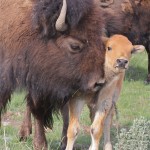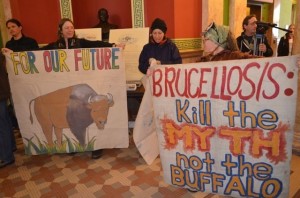We have much more to do and your continued support is needed now more than ever.
Kill the Bad Bills, Not the Buffalo: UPDATED
Last March marked a historic step forward in restoring wild bison to the American prairies when more than 60 bison from Yellowstone National Park were released on the Fort Peck Reservation in eastern Montana.

It was a huge milestone in efforts to restore bison to the wild. The bison is the one large mammal driven to near extinction that hasn’t been re-established on the Western landscape. Elk, deer, big-horn sheep
As important as the transfer of bison to Fort Peck was, a barrage of anti-bison bills in the Montana Legislature makes clear that the path to further progress will be anything but smooth.

Montana Lawmakers Fighting Restoration
The National Wildlife Federation has joined other sportsmen’s and conservation groups, the tribes and wildlife advocates to defeat the legislation. Some bills have been killed, but others that could block returning the bison to its home on the plains – to tribal lands and the Charles M. Russell National Wildlife Refuge – are still in play.
The proposals range from a ban on transferring wild bison anywhere in Montana except the National Bison Range to a bill that would hold the state Department of Fish, Wildlife and Parks liable for any damage to private property by wild bison. Another would allow county commissioners to ban restoration of wild bison in their counties, even on tribal and federal lands. State Senator John Brenden, an outspoken proponent of the bad bison bills, recently remarked,”Why do you want to spread this creeping cancer, these woolly tanks, around the state of Montana?”

Last year’s bison release on Fort Peck followed two decades of work by the tribes, conservation groups, and state and federal officials. The Yellowstone bison’s genetics date to an era when millions of bison roamed North America and were fundamental to Plains Indians’ physical, cultural and spiritual nourishment.
Yellowstone bison are special to the tribes because they are the last wild, free-ranging herd. For years, the tribes, NWF and other groups have urged that bison wandering out of Yellowstone be transferred to tribal and federal lands rather than be gunned down because of fears they’ll spread the disease brucellosis to cattle.
Ungrounded Fears
The disease can cause pregnant animals to abort, but there have been no confirmed cases of bison transmitting brucellosis to cattle. Bison transferred from Yellowstone have been quarantined and are brucellosis-free.
Last Friday, the Montana House Agriculture Committee voted 9-8 in favor of a bill sponsored by Brenden that would change bison hunting regulations, allow private landowners to shoot bison if they wander onto their land, and prohibit the relocation of bison anywhere in the state, including the transfer of bison from Fort Peck to Fort Belknap, except the National Bison Range. If the bill passes, Pat Flowers, a supervisor with Montana Fish, Wildlife and Parks, said, “the state would lose the cooperation of tribes who have been exercising their treaty rights to kill bison that leave Yellowstone National Park in the winter.”
It’s time for a halt to the war on bison. Will you stand with the tribes and their conservation allies? Will you stand with the bison? These animals belong on the Western countryside, along with all the other wildlife that are crucial elements of the ecosystem, our heritage and culture. They can once again be a vital part of tribes’ economic and spiritual lives, connections to the natural world, and their children’s future. The bison’s homecoming is long overdue.
UPDATE – May 9, 2013
The National Wildlife Federation (NWF) and over 53,000 members and activists sent a clear message for the Montana legislature to call off its assault on bison.
One of the worst bills was killed two weeks ago after thousands of you responded to appeals from NWF. The bill by state Senator John Brenden would have changed bison hunting regulations, allowed private landowners to shoot bison if they wandered onto their land, and prohibited the relocation of bison anywhere in the state. Brenden recently remarked, “Why do you want to spread this creeping cancer, these woolly tanks, around the state of Montana?” This type of anti-wildlife rhetoric was also seen in House Bill 396, vetoed by Montana Governor Steve Bullock, that would have required county commissioner approval before any bison were relocated. Clearly, many more people see bison as an important wildlife species to be preserved and recognize their value to grassland ecosystems and other wildlife.
On Monday, Montana Governor Steve Bullock vetoed the two remaining bison bills. Senate Bill 305 would have prohibited using bison that have ever been privately owned for restoration to other lands. Senate Bill 256 would have made Montana Fish, Wildlife, and Parks liable for any damages resulting from wild bison that had been relocated or released.
NWF members and activists stood up for bison, and the Montana legislature and Governor Bullock listened. With a swipe of his pen, Bullock demonstrated that he agrees with NWF that bison belong on Montana public and tribal lands.
TOGETHER, we killed the bad bills, and now bison have a new future in Montana.
![]() Donate today and help NWF continue our fight for wildlife — like bison — across the county>>
Donate today and help NWF continue our fight for wildlife — like bison — across the county>>





















